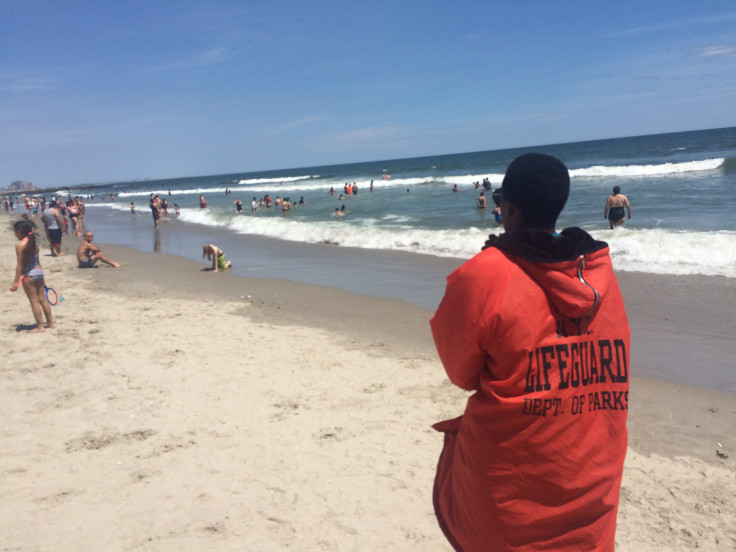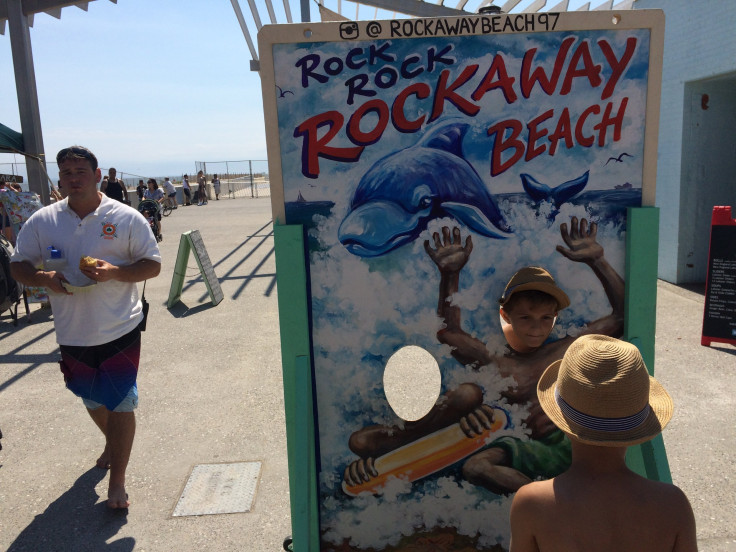‘Jaws’ Movie Anniversary: 40 Years After The Film Terrorized Beachgoers, Many Say Monster Sharks Are Fiction

NEW YORK – On a recent Sunday at New York City’s Rockaway Beach in Queens, an unseen aircraft scribbled a message across the blue sky as swimmers bobbed like apples in the surf. Competing speakers blared songs from Chris Brown, Tyga and Drake while police officers patrolled between beach towels, looking for rule breakers. In the water, a man in a snorkel mask and wetsuit trailed a young girl who kicked and laughed on a boogie board. On one of the first warm weekends of the summer, the potential for a shark attack hadn't crossed anyone's mind.
Forty years after the June 20, 1975 debut of “Jaws,” a movie that forever changed many beachgoers’ perceptions about going in the water, the fear of being dragged under and devoured by a great white had been overshadowed for many by concerns over sunburn, riptides, being cited for public drinking and the occasional uprooted umbrella. The shift follows decades of shark conservation efforts and increased public awareness of shark behavior, which have tempered people’s imaginations about those supposedly menacing creatures from the deep. Today, the average beachgoer can differentiate the famous beast that terrorized the fictional New England community of Amity Island from the real thing.
Most visitors to Rockaway had seen "Jaws," or at least knew the premise, but said it by no means kept them out of the water. “Two years ago in Cabo I swam with them – six-, seven-foot-long sharks,” said Tomek Dybus, 53, a New York construction worker who sat on the beach squeezing lime juice into two gin and tonics – one for himself and one for his wife, Jola Dybus – made from ingredients he hid in a small cooler. “The master diver telled us they were afraid of us,” he said. “The sharks would come and look at us and you could hear the music in your head – da dum, da dum, da dum – but I wasn’t scared.”

Not Such A Scary Fish After All
For decades “Jaws” paralyzed the American public and fueled misconceptions about the dangers of sharks, despite shark attacks being extremely rare. Not long after the movie hit theaters, sport fisherman began hunting the animals as trophies in organized tournaments, and U.S. shark populations plummeted because of it. Prior to those tournaments, sharks were largely considered nuisances that made ugly wall ornaments. Commercial fisheries further precipitated sharks’ decline in the 1980s as the U.S. government encouraged fishermen to hunt sharks in order to allow other depleted fish populations to rebound.
By the 1990s, some species’ numbers had dropped by as much as 90 percent. Larger sharks were the first to go. “Tournaments that were previously won with 1,000-pound animals were suddenly being won with animals that were 100 pounds,” said Bob Hueter, shark scientist at the Mote Marine Laboratory in Sarasota, Florida.
At the same time, the increased attention on sharks underscored the need for protecting them and gave scientists a reason to study the animals. Such research let the public see sharks for what they really are: finned, toothy creatures just trying to get by that occasionally – and by no fault of their own – mistake swimmers for supper.
“What conservation efforts have done is take the ‘Jaws’ image of the shark as a man-eater intent on killing people and eating people to one of the shark as a very important part of a healthy ocean,” said Hueter. “Those messages have gotten out and people get it. It’s even gone so far as to make people affectionate toward sharks.”
Some sharks even have their own fanbases. A whopping 3,456-pound, 16-foot-long great white named Mary Lee, who was fitted with a tracking device in 2012 that allows social media users to watch her move along the Eastern Seaboard, has over 76,000 followers on Twitter. Many of her Internet devotees interact with the shark’s Twitter page, even joking about there being great restaurants in Cape May. One fan of Mary Lee shared photos of a shark tattoo she recently had done “because I'm a fan of you and all Sharks.”
“If people had heard about a shark that size in 1975, they would have said, ‘get out there and kill it.’ Now people sort of adopt it as their own,” said Hueter.

The Making Of A Killer
Despite the public’s immediate negative reaction to “Jaws,” many said the movie was simply too hokey to be taken seriously anymore in the age of advanced computer-generated imagery. “I was probably nine when I saw all of them, and I was terrified,” said Miranda Hall, a 29-year-old menswear designer in Manhattan who had just emerged from a dip in the ocean. “I watched it recently, and I thought, how did this ever scare me, the graphics are so terrible!”
But “Jaws” was an instant success in 1975 and quickly became the highest-grossing film of all time, a title it lost to George Lucas’ “Star Wars” two years later. The film helped shape director Steven Spielberg’s reputation as a master of box office blowouts. The movie was filmed on location in Martha’s Vineyard in Massachusetts and centered on the fictional resort town of Amity Island, where families flock for the summer to enjoy the sun and sand. A series of gruesome attacks by a rogue great white shark leads the local police chief on a dramatic hunt for the fearsome predator.
“Bruce,” as the mechanical Jaws prop was named – a slight to director Spielberg’s attorney Bruce Ramer – was hardly fooling anyone. On camera, the shark’s teeth looked too white, its eyes crossed, and its jaws closed awkwardly.
In fact, because the shark kept breaking down, it was not used in as many scenes as Spielberg had originally intended. The film’s success as a thriller was later attributed to Bruce's absence because viewers’ imaginations made better villains than did a tin can with teeth. Spielberg ended up using camera angles to signify Jaws – pointing the lens up toward a swimmer’s legs to give the impression she was being stalked – instead of Bruce and - voila! - a killer was born.
It was those shots that many viewers found so terrifying. “The best part of the movie was that opening scene,” in which Chrissie Watckins, played by actress Susan Backlinie, is thrashed about by an underwater predator during a late night dip, said Robert Snyder, a legislative aide for Hempstead, New York councilman Anthony Santino. Snyder, who sat in a purple armchair under an umbrella, was at the beach with his daughter Liz Snyder, her husband John and their two children, 2-year-old Lukas and 4-year-old Nicky, who wore matching Spiderman hoodies and were digging in the sand.
“Once you saw the shark, it looked fake,” he said. “It would have been better if they had never shown the shark at all.”
Hall admitted that she sometimes gets nervous if she swims in deeper water, but that she doesn’t worry about sharks at Rockaway like she would if she lived somewhere like Florida or North Carolina, where, just a few short hours after Hall’s swim in the ocean, separate shark attacks resulted in two teens losing limbs. A 10-year-old boy was bitten on the calf by a shark, but was not hospitalized, in Daytona Beach Shores, Florida on Wednesday. A week before, another 10-year-0ld boy was attacked just 60 miles south near Cocoa Beach, Florida and suffered “significant injuries,” authorities said.

How Dangerous Are They, Really?
Shark attacks typically make headlines, often sparing none of the gory details, but compared to other natural threats, they’re hardly worth getting worked up over. In 2014, just three people died in shark attacks worldwide. The first involved an Austrian man who was mauled while swimming in South Africa; the second and third involved swimmers in Australia. That was seven less than the number of people killed by sharks the previous year.
There were 72 shark attacks in 2014, and the statistics show that the number of shark attacks has been steadily rising for decades, something shark experts attribute to human population growth along coasts, not sharks’ increasing appetite for human flesh. The U.S. has seen a slight uptick in shark attacks in recent years, especially in Florida, which accounts for half of all shark attacks in the country.
Despite more Americans hitting beaches, the likelihood of a swimmer being bitten by a shark is very low. The average beachgoer in the U.S. is far more likely to die from a bee sting or a snakebite or even a pet attack than a from a shark bite.
“You have more of a chance of getting hit in the head with a coconut or getting struck by lightning” than getting attacked by a shark, said Sean Lyons, 24, a landscape architect from Brooklyn who wore dusty purple swim trunks and black shades.

Some Fears Linger
That’s not to say the prospect of a shark attack doesn’t cause the occasional beach frenzy. “Last time I was here, they did see a fin in the water, so they started pulling people out. A few people were running,” recalled Liz Snyder, a 31-year old freelance producer who lives in Queens. “Then there was another fin, and another fin, and another,” she said. “It was a family of dolphins.” Snyder remembered being “freaked out” the first time she saw "Jaws," when she was young, but said that as an adult she knew that wasn’t how sharks acted in real life.
Still, while the story was highly exaggerated, “Jaws” was based partially in fact. A string of shark attacks near the Jersey Shore in 1916, in which four people were killed and one was injured, became the fodder of Peter Benchley’s 1974 book “Jaws.” Benchley took the legend of a man-eating shark stalking New Jersey beachgoers, embellished it, and produced a book that preyed on people’s fears about the unknown. Enter Spielberg, who put a face – albeit a lousy one – to those fears and broadcasted it to millions across the globe.
“It did indeed scare the bejesus out of the world, not just the country,” said Samuel Gruber, director of the Bimini Sharklab research facility in the Bahamas. Gruber consulted with Spielberg on the movie “Jaws” when the director needed to learn about shark behavior and has become known as the “old shark doc” for his decades of work in shark conservation.
He said he believed many people still fear sharks, and that the basis of those fears, even when irrational, was hard to put a finger on. “If a thousand people got killed and mashed up into hamburger in a giant highway crash, that wouldn’t bother anybody,” said Gruber. “But a kid gets his arm bitten off and [the media] goes on, and on and on and on. There’s something deeply psychological about a fish killing a man.”
Back at Rockaway, as beachgoers sipped beers or Mike’s Hard Lemonades out of paper or plastic bags, the occasional advanced swimmer could be seen paralleling the beach beyond where the waves broke, their glistening figures disappearing down the coastline. Even those who dismissed the threat of sharks said their resolves weren’t fixed.
As one sunbather put it, “If I saw someone getting eaten by a shark, I’d be like f---, that sh--‘s real.”
© Copyright IBTimes 2024. All rights reserved.












